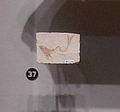
The Natural History Museum in London is a museum that exhibits a vast range of specimens from various segments of natural history. It is one of three major museums on Exhibition Road in South Kensington, the others being the Science Museum and the Victoria and Albert Museum. The Natural History Museum's main frontage, however, is on Cromwell Road.

The National Museum of Natural History (NMNH) is a natural history museum administered by the Smithsonian Institution, located on the National Mall in Washington, D.C., United States. It has free admission and is open 364 days a year. With 4.4 million visitors in 2023, it was the second most-visited museum in the United States.
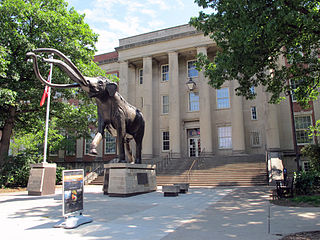
The University of Nebraska State Museum, also known as Morrill Hall, founded in 1871, is a natural history museum featuring Nebraska biodiversity, paleontology, and cultural diversity, located on the University of Nebraska–Lincoln City Campus near the corner of 14th and Vine Streets in Lincoln, Nebraska, United States. The museum houses Mueller Planetarium, a hands-on science discovery center, and the Elephant Hall, where visitors can see the world's largest articulated fossil mammoth among the collection of fossil elephants. Also featured are interactive paleontology exhibits, a dinosaur gallery, ancient life and evolution exhibits, wildlife dioramas, gems and minerals, American Indian and African exhibits, and a temporary exhibit gallery featuring rotating displays on diverse topics including photography, quilts and fine arts.
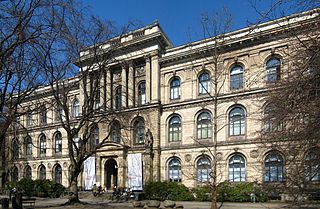
The Natural History Museum is a natural history museum located in Berlin, Germany. It exhibits a vast range of specimens from various segments of natural history and in such domain it is one of three major museums in Germany alongside Naturmuseum Senckenberg in Frankfurt and Museum Koenig in Bonn.

Carnegie Museums of Pittsburgh is a nonprofit organization that operates four museums in Pittsburgh, Pennsylvania, United States. The organization is headquartered in the Carnegie Institute and Library complex in the Oakland neighborhood of Pittsburgh. The Carnegie Institute complex, which includes the original museum, recital hall, and library, was added to the National Register of Historic Places on March 30, 1979.

The Sam Noble Oklahoma Museum of Natural History is the officially designated natural history museum for the State of Oklahoma, located on the campus of the University of Oklahoma. The museum was founded in 1899 by an act of the Oklahoma Territorial Legislature. Its current building was completed in 1999 under the leadership of Michael A. Mares, who was director from 1983-2003 and from 2008-2018. The museum contains more than 10 million objects and specimens in 12 collections. The current building is a 198,000-square-foot facility with almost 50,000 square feet of public space, with five permanent and two temporary galleries and exhibits that provide an in-depth tour of Oklahoma's natural and cultural history. The remainder of the facility is dedicated to housing museum collections, laboratories, libraries, and offices. It is one of the world's largest university-based natural history museums.

The Denver Museum of Nature & Science is a municipal natural history and science museum in Denver, Colorado. It is a resource for informal science education in the Rocky Mountain region. A variety of exhibitions, programs, and activities help museum visitors learn about the natural history of Colorado, Earth, and the universe. The 716,000-square-foot (66,519 m2) building houses more than one million objects in its collections including natural history and anthropological materials, as well as archival and library resources.

The Burpee Museum of Natural History is located along the Rock River in downtown Rockford, Illinois, United States, at 737 North Main Street.
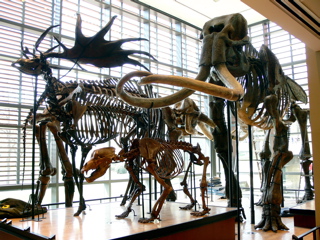
The Beneski Museum of Natural History, Amherst College, is located on the campus of Amherst College in Amherst, Massachusetts. It showcases fossils and minerals collected locally and abroad, many by past and present students and professors. The museum is located in the Beneski Earth Sciences Building, completed in 2006. It is a member of Museums10.

The North Carolina Museum of Natural Sciences (NCMNS) is a natural history museum in Raleigh, North Carolina. The museum is the oldest in the state, and the largest natural history museum in the Southeastern United States.

Tyrannosaurus is one of the most iconic dinosaurs and is known from numerous specimens, some of which have individually acquired notability due to their scientific significance and media coverage.

The Museum of Evolution of Uppsala University is a natural history museum in Sweden, and holds Scandinavia's largest fossil collection of dinosaurs. The number of items in today's collection, which spans zoological, paleontological and mineralogical specimens, is approximately 5 million unique pieces, of which only a fraction are exhibited. Expeditions to China in the 20th century unearthed numerous unique paleontological treasures. The museum's collection contains three teeth of the Peking Man, found by paleontologist Otto Zdansky during an expedition to Zhoukoudian in 1921. Due to its large collection of type specimens the museum is an important establishment in the field of biological systematics, and it maintains an active exchange with other scientific institutions worldwide.
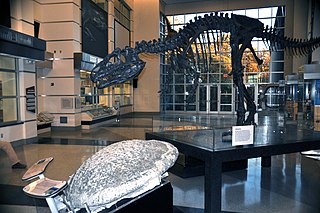
The Virginia Museum of Natural History is the state's natural history museum located in Martinsville, Virginia founded in 1984. The museum has several different award-winning publications, is affiliated with the Smithsonian Institution, and has more than 22 million items. This includes the first intact stromatolite head ever found in Virginia, which is one of the largest complete 'heads' in the world, at over 5 feet in diameter and weighing over 2 tons.

The Natural History Museum of Zimbabwe is located in Bulawayo, Zimbabwe, on Leopold Takawira Avenue.

The University of Michigan Museum of Natural History (UMMNH) is a natural history museum of the University of Michigan in Ann Arbor, Michigan, United States.

The Museum of Paleontology Egidio Feruglio is a science research and exhibition center in Trelew city, Patagonia, Argentina. Its permanent and travelling exhibitions focus on the fossil remains of fauna and flora of Patagonia, and the changes that affected the region over geological time. The museum is named for geologist Egidio Feruglio.

The Raymond M. Alf Museum of Paleontology is a paleontology museum in Claremont, California, that is part of The Webb Schools. It is the only nationally accredited museum on a secondary school campus in the United States. The museum has two circular 4,000 sq. ft. exhibition halls and 20,000 unique annual visitors. The collections number about 140,000 specimens, 95% of which were found by Webb students on fossil-collecting trips called “Peccary Trips,” expeditions usually centered in California, Utah, and Montana. The collections consist primarily of vertebrate, invertebrate, and track fossils and the museum's large track collection is widely recognized as one of the most diverse in the world.
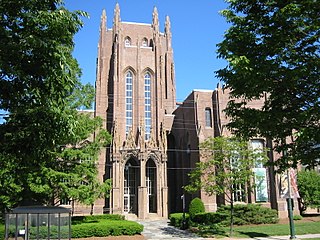
The Peabody Museum of Natural History at Yale University is one of the oldest, largest, and most prolific university natural history museums in the world. It was founded by the philanthropist George Peabody in 1866 at the behest of his nephew Othniel Charles Marsh, an early paleontologist. The museum is best known for the Great Hall of Dinosaurs, which includes a mounted juvenile Brontosaurus and the 110-foot-long (34 m) mural The Age of Reptiles. The museum also has permanent exhibits dedicated to human and mammal evolution; wildlife dioramas; Egyptian artifacts; local birds and minerals; and Native Americans of Connecticut.

The Mace Brown Museum of Natural History is a public natural history museum situated on the campus of The College of Charleston, a public liberal arts college in Charleston, South Carolina. With a collection of over 30,000 vertebrate and invertebrate fossils, the museum focuses on the paleontology of the South Carolina Lowcountry. Admission to the museum is free, and donations are welcome. The museum has the holotype specimens of Coronodon, Cotylocara, and Inermorostrum, as well as the reference specimen of Ankylorhiza tiedemani







